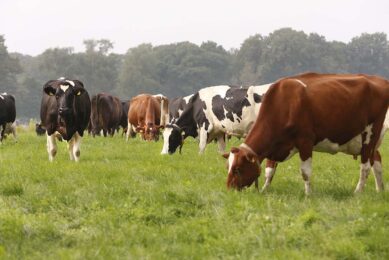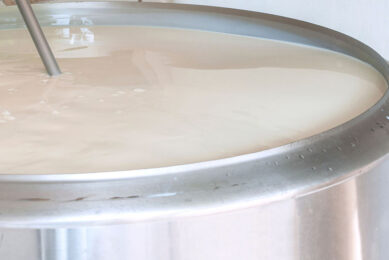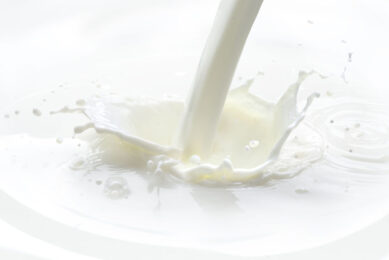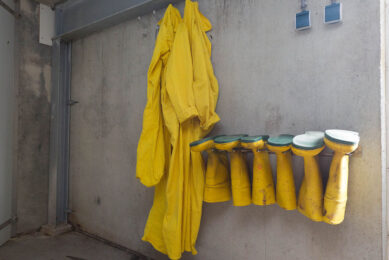Effectiveness of disinfectants on biofilms
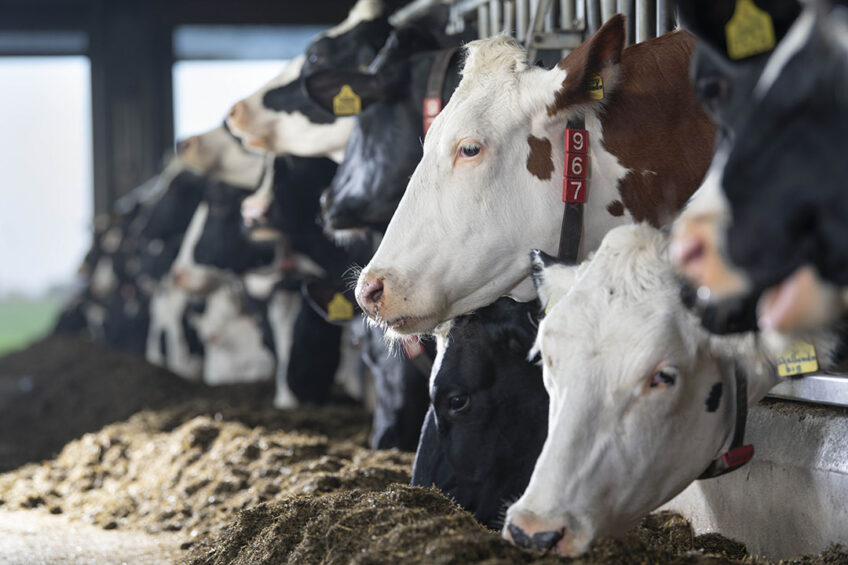
Microbiological contamination through formation of bacterial biofilms in dairy equipment compromises the quality and safety of milk and milk products. We take a deeper look at the effectiveness of disinfectants on biofilms in dairy equipment.
Biofilms on the surfaces of dairy equipment threaten not only the quality and safety of dairy products, but also the economic viability of dairy enterprises and the sustainability of the entire dairy industry. Bacterial biofilms occur at all stages of dairy processing, from raw milk collection through to waste treatment. Studies show that biofilms on dairy processing lines are characterised by rapid development, mostly within 12 hours. Biofilm control currently relies on the effectiveness of clean-in-place systems. A shortage of information on the development and control of biofilms in the dairy industry is pushing research towards establishing effective control strategies.

The following sections present results from the work of researchers from Massey University (New Zealand) and National Technical University (Ukraine) who carried out separate studies to shed more light on the features of formation of dairy equipment microflora, the ability of micro-organisms to form biofilms on non-corrosive steel surfaces and the effectiveness of disinfectants.
Formation of biofilms
The ability to form biofilms allows micro-organisms to survive on most technological equipment. A microbial biofilm is a formation of one or several species or genera of bacteria, fixed to the surface and surrounded by a matrix. Biofilm creation involves 4 main stages:
- The adhesion of bacteria to a surface;
- Micro-colony formation or microbial mass growth, feeding from the matrix;
- Maturation through quorum sensing (cell-to-cell signalling);
- Detachment or dispersion of biofilm.
Microbial adhesion mainly depends on the bacteria species and the physical and chemical properties of the surface to which it attaches. The formation of extracellular polymeric substances (the matrix) occurs during the attachment stage of the biofilm to the surface. The matrix provides a medium that facilitates the interaction of the micro-organisms in the biofilm. Studies show that micro-organisms constitute 5–35% of the biofilm volume, while the rest is made up of the extracellular matrix. The last stage of biofilm formation (detachment stage) sees microbial cells and enzymes transferred to new sites, thus propelling contamination and aiding potential spread of infection.
 Keeping costs down with sharemilking
Keeping costs down with sharemilking
Keeping the costs down to achieve a decent profit is the main goal for a young Scottish couple currently sharemilking on a farm in New Zealand.
The challenge with biofilms
The major problem with cleaning and disinfection of biofilms is their resistance to disinfectant treatment. Studies indicate prevalence of biofilms of different bacteria, both saprophyte and pathogenic bacteria extracted from dairy equipment, despite cleaning and disinfection with several agents. Thus, the ability of the bacteria to form biofilm on dairy equipment surfaces is an important condition of their survival and corresponding contamination of milk products. This calls for research to focus on studying the characterisation of dairy equipment microflora, the ability of different bacteria to form biofilms, the composition of biofilms, the differences of equipment surface and possible effects emanating from the processing conditions or type of products. This could allow a deeper understanding of the adhesion process, resulting in better development and selection of the most effective sanitary treatments of dairy equipment.
Surface roughness
The type of surface found in dairy equipment plays a big role in development of bacterial biofilms. Although non-corrosive steel is mainly used for the dairy equipment, differences in roughness are common at the microscopic level. The influence of surface roughness on the process of biofilm formation on non-corrosive steel used as dairy equipment was realised by studying Escherichia coli bacteria. The roughness of surfaces was measured in mcm (where 1mcm = 0.5mm2). The researchers evaluated 3 different surfaces with roughness values of 0.16mcm, 0.63mcm and 0.955mcm. For each of these roughness levels, a corresponding measurement of the density of E. coli was recorded. Observations were made during a 24-hour incubation period at 17°С.
 Covid-19: The impact on the dairy hygiene supply chain
Covid-19: The impact on the dairy hygiene supply chain
One thing we can be sure of is that the Covid-19 pandemic has brought much uncertainty in many sectors, including whether distributors would still be able to get stock of hygiene products to dairy farmers.
The results demonstrated that the less rough the surface, the slower the process of the initial adhesion to the surface for biofilm formation. The roughness of surfaces influences the process of biofilm formation and density of E. coli; on the non-corrosive steel surface with the roughness of 0.16mcm, E. coli forms biofilms of lower density compared to on the surface with a roughness of 0.63mcm, while the densest biofilms were found on the highest roughness of 0.955mcm. Thus, the research indicated that dairy equipment in direct contact with the product must have a surface roughness that hinders both the process of initial bacteria adhesion and subsequent biofilm formation. Additionally, the density of biofilms would be expected to influence the effectiveness of sanitary processing by disinfectants – this is confirmed in the section below describing the effectiveness of disinfectants. It would be interesting to determine how different microbes respond to differences in surface roughness.
Prevalence of microbes
Research findings show that the most prevalent bacteria in contamination of dairy equipment are the Bacillus cereus and the Enterococcus faecalis. Micro-organisms of Staphylococcus, Streptococcus and Pseudomonas genera were less prevalent when extracts were collected from the equipment. Following the analysis of these collected samples, it was clear that even with standard sanitary processing, dairy equipment is not sterile since micro-organisms that form microflora of final products were extracted from its surface.
 How to rear healthy youngstock
How to rear healthy youngstock
Hygiene is a major factor when it comes to healthy calves, but what are the main points to consider?
To study the possibility of resistance, the density of common bacterial biofilms in dairy equipment was determined. The density of created biofilms was considered low when the density was less than 0.5, medium when the density was in the range 0.5–1.0 and high when density was higher than 1.0. A denser biofilm formation testifies to the fact that bacteria in a formed biofilm can remain on internal surfaces of dairy equipment for a long time and play a key role in the contamination of products. The densest biofilms (density 1.75–1.77) were formed by bacteria of B. cereus and E. faecalis genera in 100% of cases. The medium-dense biofilms were observed with the Pseudomonas aeruginosa, E. coli, and Enterococcus fаecium. The least dense biofilms (1.13–1.21) were formed by bacteria of Streptococcus agalactiae and Lactobacillus spp., corresponding to 28–58% of cases.
Are disinfectants effective?
The major problem with cleaning and disinfection of biofilms is their resistance to chemical treatment. In their study, researchers at the National Technical University found that biofilms of P. aeruginosa of dairy origin were resistant to 3 disinfectants: benzalkonium chloride, iodophor and sodium hypochlorite treatment. In the same study, the influence of another batch of disinfectants used for the sanitation of dairy equipment at milk-processing enterprises was evaluated. The preparations included active substances such as quaternary ammonium compounds, chlorine and nanoparticles of silver. These preparations ranged from having no effect to being weakly effective against film-creating bacteria forming. Furthermore, it was also established that working solutions of disinfectants P3-ansep CIP, Eco chlor, Medicarine and Maxidez were less effective on biofilms.

However, one disinfectant stood out: the Р3-oxonia active 150, a disinfectant based on hydrogen peroxide/peracetic acid. It is worth noting that some studies suggest that although sanitisers based on peroxygens can eliminate spores, they are usually corrosive at high temperatures and concentration. The current study was done at the low temperature of 17°С.
 India: Ensuring hygiene standards in the dairy sector
India: Ensuring hygiene standards in the dairy sector
Hygiene and quality of dairy products have become a very important issues after a recent survey report by the Food Safety and Standards Authority of India (FSSAI) found that most of the milk consumed in the country is adulterated.
Surface disinfectant
According to ECOLAB, P3-oxonia active 150 is a surface disinfectant that can be used in the dairy, beverage and food processing industries, as well as for sterilisation of aseptic processing and packaging equipment. It is effective against all types of micro-organisms (broad spectrum) but most efficient at low temperatures. It is also pH range tolerant, being effective from acidic to neutral pH. It is environmentally friendly, having a minimum amount of phosphate and zero chlorine.
Basic requirements for sanitation at the processing facilities are effectiveness, economy and safety. An effective and safe sanitation regime reaches economic effectiveness if the sanitation agent can be easily washed out, has low demand on energy, is highly effective and offers the least damage to the environment and disinfected surfaces. In this study, the researchers also showed that bacterial strains with “qac genes” were able to grow in a high concentration of benzalkonium chloride, which is commonly used as a disinfectant. They concluded that, by understanding biofilms, control strategies can be developed to control the proliferation of the microbial population in the dairy environment.
 6 tips for supporting ruminant feed safety
6 tips for supporting ruminant feed safety
In this article, we look at 6 tips for supporting ruminant feed safety.
Alternatives to disinfectants
The use of quorum sensing inhibitors to prevent biofilm formation is a recent technique for further exploration. During quorum sensing, bacterial cells communicate through cell-to-cell signalling to regulate their physiological processes as they growth to mature biofilms. Another possibility is to apply surface coatings; some studies have shown that modification of stainless-steel surfaces using Ni-P-polytetrafluoroethylene or sol-gel (thermolon) can significantly reduce bacterial fouling, leading to reduced biofilm formation during milk pasteurisation. Several phytochemicals have also been reported to be effective in inhibiting biofilm formation; however, their limitations could be the development of flavours in the products. Another possibility is the cavitation treatment, where the cavitation will inactivate bacterial spores to reduce their ability to adhere to surfaces.
Cleaning efficiency
High cleaning frequency is important since the resistance of biofilms to chlorine has been reported to significantly increase as the age of biofilm increases. The quality of water is also crucial; flush water can be a major source of microbial contamination. It is ideal for dairies to determine the presence of micro-organisms in the final flush water – this should not exceed the permissible total viable counts. Several studies show that the most contaminated surfaces are the areas located after bends, which means cleaning strategies should pay more attention to these zones. To achieve the most effective cleaning-in-place results, it is necessary to design all equipment with equal consideration to production and cleaning requirements.
This article is based on the original articles by Flint S, Bremer P, Brooks J, Palmer J, Sadiq F, Seale B, Teh KH, Wu S and Md Zain SN. 2019. Bacterial fouling in dairy processing. International Dairy Journal, https://doi.org/10.1016/j.idairyj.2019.104593; and Kukhtyn M, Berhilevych O, Kravcheniuk K, Shynkaruk O, Horyuk Y and Semaniuk N. 2017. The influence of disinfectants on microbial biofilms of dairy equipment. Food Science and Technology, DOI:10.21303/2504-5695.2017.00423.



